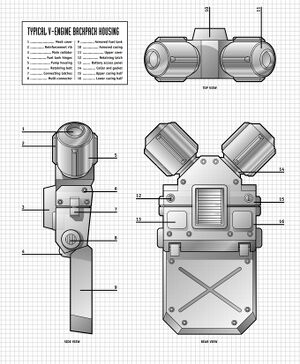V-Engine
Most Gears use an advanced, very compact internal combustion powerplant called a V-engine. Based on designs developed at the University of the Colorado in the later years of the twentieth century, the V-engine — so named because of its shape — is a twin drive, air cooled powerplant with high efficiency and minimal moving parts.
The core of the V-engine is a support axle made out of high-strength alloy steel. It is truly only a bent bar of metal, and is the strongest part of the engine. Two cylindrical combustion chambers, which look a lot like a revolver’s magazine, are slipped over this support axle. These chambers, per their peculiar internal shape, serve as piston housing, distributor cap, lubrication system and cooling fan, all in one.
The engine’s design thus provides two drive shafts, each delivering equal horsepower. A number of V-shaped pistons (the actual number varies between six and twelve depending on the model) rotate around the support axle, compressing the fuel-air mixture as they go, until the mixture is transferred to the combustion chambers and ignited.
The chambers rotate inside an outer shell made out of a high strength metallic alloy. The engine support pins are molded directly into the shell, as is the air intake. The end result is a fairly compact engine that is rugged, easy to manufacture and easy to repair. The small number of moving parts and the V-engine’s ability to use a variety of fuels make it perfectly suited for Heavy Gears.
A few rare Gear models are powered by electrical motors fed by a bank of ambient temperature superconducting coils. The enormous cost of such a system, however, and its inherent limitations, make it unpopular except in specialized “stealth” units or as a back-up system. Its short operating range is also a problem that has yet to be solved. Electrically powered Gears are easily recognized by their distinctive backpack that contains the bulky superconducting capacitors, providing power to a single fluid pump (the generator is obviously not needed in this design).
Experiments were also performed with gas turbines, mostly in the proposed “Hover Gear” programs that have come and gone throughout the years. Some gas turbines have the added advantage of providing residual thrust that is used both for the hoverfans and a limited jumping capacity. Unfortunately, they tend to require extensive maintenance (at least when compared to the more efficient V-engine) and are more expensive to manufacture. Smaller gas turbines with no exhaust jet capacity have been used as back-up powerplants in several stealth designs, where they are used to recharge the battery array when the stealth function is not needed.
Unfortunately, no Terranovan fusion engine was ever made small enough to fit into a Gear — or any other vehicle smaller than a space shuttle for that matter.
Fuel
The advanced design of the V-engine enables it to use a wide range of fuels. As long as the fuel employed is gaseous or liquid and is reasonably combustible, the engine will function (although with a varying degree of efficiency). Of course, the use of improper fuel may result in a reduced deployment range and/or engine life.
The best fuel is refined vehicle-grade gasoline or kerosene. This is not always available, however (especially when trapped behind enemy lines), and Gears have been known to run on fuels as diverse as natural gas, alcohol, machine oil, liquid rocket fuel and even industrial cleaning solvent.
Refueling
Most Gears carry their fuel within an armored, self-sealing tank located in the rear hip armor plate. The flexible fuel lines are located underneath, well hidden from enemy fire. The refueling ports (there are generally two of them) are also mounted under the plate, but near the side edges. Universal adapters allow the ports to fit almost any size of fuel hoses under 15 cm.

